Douglas A-26 Invader
The Douglas A-26 Invader (designated B-26 between 1948 and 1965) is an American twin-engined light bomber and ground attack aircraft. Built by Douglas Aircraft Company during World War II, the Invader also saw service during several major Cold War conflicts. A limited number of highly modified United States Air Force aircraft served in Southeast Asia until 1969. It was a fast aircraft capable of carrying a large bomb load. A range of guns could be fitted to produce a formidable ground-attack aircraft.[4]
| A-26 (B-26) Invader | |
|---|---|
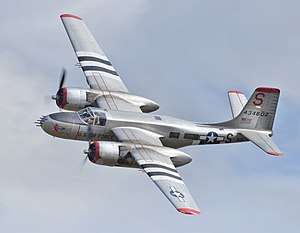 | |
| A warbird A-26 Invader | |
| Role | Ground attack Light bomber |
| Manufacturer | Douglas Aircraft Company |
| First flight | 10 July 1942 |
| Retired | 1980 Colombian Air Force[1] |
| Primary users | United States Army Air Forces United States Air Force United States Navy French Air Force |
| Number built | 2,503[2] |
| Unit cost |
US$242,595 (1942)[3] |
| Variants | On Mark Executive, Marketeer, and Marksman |
A re-designation of the type from A-26 to B-26 led to confusion with the Martin B-26 Marauder, which first flew in November 1940, some 20 months before the Douglas design's maiden flight. Although both types were powered by the widely used Pratt & Whitney R-2800 Double Wasp eighteen-cylinder, double-row radial engine, they were completely different and separate designs – the Martin bomber originated in 1939, with more than twice as many Marauders (nearly 5,300) produced in comparison to the Douglas design.
Design and development
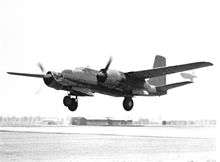
The A-26 was Douglas Aircraft's successor to the A-20 (DB-7) Havoc, also known as Douglas Boston, one of the most successful and widely operated types flown by Allied air forces in World War II.
Designed by Ed Heinemann, Robert Donovan, and Ted R. Smith,[5] the innovative NACA 65-215 laminar flow airfoil wing of the A-26 was the work of project aerodynamicist A.M.O. Smith.[6][7]
The Douglas XA-26 prototype (AAC Ser. No. 41-19504) first flew on 10 July 1942 at Mines Field, El Segundo, with test pilot Benny Howard at the controls. Flight tests revealed excellent performance and handling, but engine cooling problems led to cowling changes and elimination of the propeller spinners on production aircraft. Repeated collapses during testing led to reinforcement of the nose landing gear.[8]
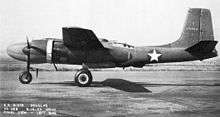
The A-26 was originally built in two different configurations. The A-26B had a gun nose, which originally could be equipped with a combination of armament including .50 caliber machine guns, 20mm or 37mm auto cannon, or even a 75mm pack howitzer (which was never used operationally). Normally the gun nose version housed six (or later eight) .50 caliber machine guns, officially termed the "all-purpose nose", later commonly known as the "six-gun nose" or "eight-gun nose". The A-26C's "glass" nose, officially termed the "Bombardier nose", contained a Norden bombsight for medium altitude precision bombing. The A-26C nose section included two fixed M-2 guns, later replaced by underwing gun packs or internal guns in the wings.[9]
After about 1,570 production aircraft, three guns were installed in each wing, coinciding with the introduction of the "eight-gun nose" for A-26Bs, giving some configurations as many as 14 .50 in (12.7 mm) machine guns in fixed forward mounts. An A-26C nose section could be replaced with an A-26B nose section, or vice versa, in a few man-hours, thus physically (and officially) changing the designation and operational role. The "flat-topped" canopy was changed in late 1944 after about 820 production aircraft, to a clamshell style with greatly improved visibility.[10][11]
Alongside the pilot in an A-26B, a crew member typically served as navigator and gun loader for the pilot-operated nose guns. In an A-26C, that crew member served as navigator and bombardier, and relocated to the nose section for the bombing phase of an operation. A small number of A-26Cs were fitted with dual flight controls, some parts of which could be disabled in flight to allow limited access to the nose section. Access was through the lower section of the right-hand instrument panel, which was open to allow access to the nose for the bombardier, who would normally sit next to the pilot. This was similar to British designs like the Lancaster, Blenheim/Beaufort, Wellington, etc. A tractor-style "jump seat" was located behind the "navigator's seat." In most missions, a third crew member in the rear gunner's compartment operated the remotely controlled dorsal and ventral gun turrets, with access to and from the cockpit possible via the bomb bay only when that was empty. The gunner operated both dorsal and ventral turrets via a novel and complex (and problematic) dual-ended periscope sight, which was a vertical column running through the center of the rear compartment, with traversing and elevating/depressing periscope sights on each end. The gunner sat on a seat facing rearward, and looked into a binocular periscope sight mounted on the column, controlling the guns with a pair of handles on either side of the column. When aiming above the centerline of the aircraft, the mirror in the center of the column would flip, showing the gunner what the upper periscope was seeing. When he pressed the handles downward, as the bead passed the centerline the mirror would automatically flip, transferring the sight "seamlessly" to the lower periscope. The guns would aim wherever the periscope was aimed, automatically transferring between upper and lower turrets as required, and computing for parallax and other factors. While novel and theoretically effective, a great deal of time and trouble was spent trying to get the system to work effectively, which delayed production, and it was difficult to keep maintained in the field even once production started.[12]
Operational history
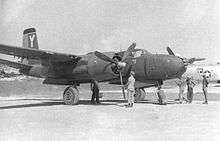
World War II
Pacific
The Douglas company began delivering the production model A-26B to the United States Army Air Forces (USAAF) on 10 September 1943,[13] with the new bomber first seeing action with the Fifth Air Force in the Southwest Pacific theater on 23 June 1944, when Japanese-held islands near Manokwari were attacked.[14] The pilots in the 3rd Bomb Group's 13th Squadron, "The Grim Reapers", who received the first four A-26s for evaluation, found the view from the cockpit to be restricted by the engines and thus inadequate for low-level attack. General George Kenney, commander of the Far East Air Forces stated that, "We do not want the A-26 under any circumstances as a replacement for anything."[15]
Until changes could be made, the 3d Bomb Group requested additional Douglas A-20 Havocs, although both types were used in composite flights.[16] The 319th Bomb Group worked up on the A-26 in March 1945, joining the initial 3rd BG, with the 319th flying until 12 August 1945. The A-26 operations wound down in mid-August 1945 with only a few dozen missions flown.[16] Several of the A-20 and B-25 AAF units in the Pacific received the A-26 for trials, in limited quantities.
Europe
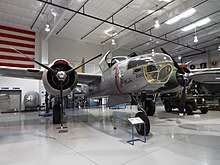
Douglas needed better results from the Invader's second combat test, so A-26s began arriving in Europe in late September 1944 for assignment to the Ninth Air Force. The initial deployment involved 18 aircraft and crews assigned to the 553d Squadron of the 386th Bomb Group. This unit flew its first mission on 6 September 1944. No aircraft were lost on the eight test missions, and the Ninth Air Force announced that it was happy to replace all of its A-20s and B-26s with the A-26 Invader.
The first group to fully convert to the A-26B was 416th Bombardment Group with which it entered combat on 17 November, and the 409th Bombardment Group, whose A-26s became operational in late November.[17] Due to a shortage of A-26C variants, the groups flew a combined A-20/A-26 unit until deliveries of the glass-nose version caught up. Besides bombing and strafing, tactical reconnaissance and night interdiction missions were undertaken successfully. In contrast to the Pacific-based units, the A-26 was well received by pilots and crew alike, and by 1945, the 9th AF had flown 11,567 missions, dropping 18,054 tons of bombs, recording seven confirmed kills while losing 67 aircraft.[17]
In Italy the Twelfth Air Force's 47th Bomb Group also received the A-26, starting in January 1945. They were used against German transport links, but also for direct support and interdiction against tanks and troop concentrations in the Po valley in the final campaigns in Italy.
Postwar era
United States
With the establishment of the United States Air Force as an independent service in 1947, the Strategic Air Command operated the now-redesignated B-26 as an RB-26 reconnaissance aircraft in service from 1949 through 1950. U.S. Air Forces in Europe continued operating the redesignated B-26 until 1957 and the Tactical Air Command operated the aircraft as both a B-26 and later redesignated back to A-26, the final variant designated as B-26K until 1966, when it again became the A-26A. This final version continued in service through the late 1960s with active duty special operations TAC units, and through 1972 with TAC-gained special operations units of the Air National Guard.
The U.S. Navy also obtained a number of Invaders from the Air Force and employed these aircraft in their utility squadrons (VU) for target towing and general utility use until superseded by the DC-130A variant of the C-130 Hercules. The Navy designation was JD-1 and JD-1D until 1962, when the JD-1 was redesignated UB-26J and the JD-1D was redesignated DB-26J. The CIA also used the type for covert operations.[18]
The last A-26 in active US service was assigned to the Air National Guard; that aircraft being retired from military service in 1972 by the U.S. Air Force and the National Guard Bureau and donated to the National Air and Space Museum.
Korean War
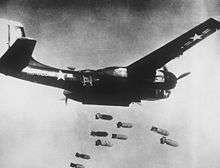
B-26 Invaders of the 3d Bombardment Group, operating from bases in southern Japan, were among the first USAF aircraft engaged in the Korean War, carrying out missions over South Korea on 27 and 28 June, before carrying out the first USAF bombing mission on North Korea on 29 June 1950, when they bombed an airfield outside of Pyongyang.[19]
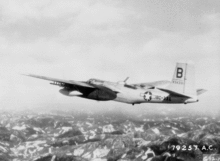
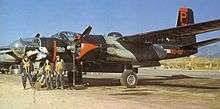
On 10 August 1950, the Air Force Reserve's 452d Bombardment Wing was activated for Korean service.[20] It flew its first missions in November 1950 from Itazuke, Japan, providing daylight support, with the 3rd Bomb Wing, consisting of the 8th, 13th and 90th Bomb Squadrons, flying night missions. Because of the Chinese intervention, it was forced to find another base and moved to Miho Air Base on the west coast of Honshū. In early 1951 it moved to Pusan East (K-9) Air Base and continued its daylight as well as night intruder missions. In June 1951, it joined the 3rd Bomb Wing (Kunsan (K-8)) in night activity only, dividing the target areas, with the 452nd taking the eastern half and the 3rd the western. For its efforts in the Korean War, it was awarded two unit citations and the Korean Presidential Citation.[20] It also received credit for eight campaign operations.
In May 1952 it was inactivated and all of its aircraft and equipment along with its regular air force personnel were absorbed by the 17th Bomb Wing. During its time as an active unit, the 452nd flew 15,000 sorties (7000 at night) with a loss of 85 crewmen.
B-26s were credited with the destruction of 38,500 vehicles, 406 locomotives, 3,700 railway trucks, and seven enemy aircraft on the ground. On 14 September 1951, Captain John S. Walmsley, Jr. attacked a supply train. When his guns jammed, he illuminated the target with his searchlight to enable his wingmen to destroy the train. Walmsley was shot down and posthumously awarded the Medal of Honor. Invaders carried out the last USAF bombing mission of the war 24 minutes before the Armistice Agreement was signed on 27 June 1953.[21][22]
In addition to the standard attack versions of the B-26 which flew night interdiction missions, a small number of modified WB-26s and RB-26s of the 67th Tactical Reconnaissance Wing flew critical weather observation and reconnaissance missions in supporting roles.[23]
Southeast Asia
The first B-26s to arrive in Southeast Asia were deployed to Takhli RTAFB, Thailand in December 1960. These unmarked aircraft, operated under the auspices of the U.S. CIA (Central Intelligence Agency), were soon augmented by an additional 16 aircraft, 12 B-26Bs and B-26Cs plus four RB-26Cs under Operation Millpond. The mission of all of these aircraft was to assist the Royal Lao Government in fighting the Pathet Lao. The repercussions from the Bay of Pigs invasion meant that no combat missions are known to have been flown, although RB-26Cs operated over Laos until the end of 1961. The aircraft were subsequently operated in South Vietnam under Project "Farm Gate".[24] The only other deployment of B-26 aircraft to Laos prior to the introduction of the B-26K/A-26A, was the deployment of two RB-26C aircraft, specifically modified for night reconnaissance, deployed to Laos between May and July 1962 under Project Black Watch. These aircraft, initially drawn from Farm Gate stocks, were returned upon the end of these missions.[25]
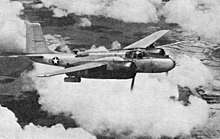
The aircraft from Laos participated in the early phase of the Vietnam War with the USAF, but with Vietnamese markings as part of Project Farm Gate. Though Farm Gate operated B-26Bs, B-26Cs, and genuine RB-26Cs, many of these aircraft were operated under the designation RB-26C, though they were used in a combat capacity.[26] During 1963, two RB-26C were sent to Clark AB in the Philippines for modifications, though not with night systems as with those modified for Black Watch. The two aircraft returned from Black Watch to Farm Gate were subsequently given the designation RB-26L to distinguish them from other modified RB-26C, and were assigned to Project Sweet Sue.[25] Farm Gate's B-26s operated alongside the other primary strike aircraft of the time, the T-28 Trojan, before both aircraft types were replaced by the Douglas A-1 Skyraider.[27] The B-26s were withdrawn from service in February 1964 after two accidents related to wing spar fatigue, one during combat in Southeast Asia in August 1963 and one during an airpower demonstration at Eglin AFB, Florida in February 1964.[28]
On 11 February 1964, two pilots from the 1st Air Commando Wing stationed at Hurlburt Field, Fla., died in the crash of a B-26 on Range 52 at Eglin AFB when it lost a wing during pull-out from a strafing pass. The aircraft was participating in a demonstration of the Special Air Warfare Center's counter insurgency capabilities and had completed a strafing run when the accident occurred. SAWC had presented the demonstration on an average of twice each month for the previous 21 months.[29] B-26 aircraft used by USAF Commandos in Vietnam were grounded 8 April 1964, following an official investigation into the 11 February accident. B-26 aircraft in use by the South Vietnamese Air Force were also grounded in accordance with the U.S. ruling.[30]
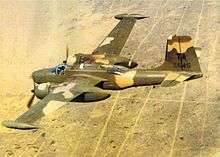
In response to this, the On Mark Engineering Company of Van Nuys, California was selected by the Air Force to extensively upgrade the Invader for a counterinsurgency role. The first production flight of the B-26K was on 30 May 1964 at the Van Nuys Airport. On Mark converted 40 Invaders to the new B-26K Counter-Invader standard, which included upgraded engines, propellers, and brakes, re-manufactured wings, and wing tip fuel tanks, for use by the 609th Special Operations Squadron. In May 1966, the B-26K was re-designated A-26A for political reasons (Thailand did not allow the U.S. to have bombers stationed in country at the time, so the Invaders were redesignated with an "A", for attack aircraft) and deployed in Thailand to help disrupt supplies moving along the Ho Chi Minh trail. Two of these aircraft were further modified with a Forward Looking Infrared (FLIR system) under project Lonesome Tiger, as a part of Operation Shed Light.[31]
CIA
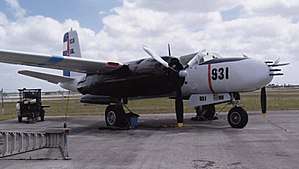
In early 1961, about 20 B-26Bs, most converted from B-26C configuration, were 'sanitized' at Duke Field (also known as Auxiliary Field Three at Eglin AFB), Florida. They had defensive armament removed, and were fitted with the eight-gun nose, underwing drop tanks, and rocket racks. They were flown to a CIA-run base in Guatemala where training was under way of B-26, C-46 and C-54 Cuban exile air crews by personnel from the Alabama Air National Guard. After transfer to Nicaragua in early April 1961, they were painted in the markings of the FAR (Fuerza Aérea Revolucionaria), the air force of the Cuban government.
On 15 April 1961, crewed by Cuban exiles, eight B-26s of the FAL (Fuerza Aérea de Liberación) attacked three Cuban airfields, in an attempt to destroy FAR combat aircraft on the ground. On 17 April 1961, FAL B-26s supported the seaborne Bay of Pigs Invasion of Cuba. The conflict ended on 19 April, after the loss of nine FAL B-26s, 10 Cuban exiles and 4 American aircrew in combat. The FAR flew B-26Cs in the conflict, one of which was shot down by a CIA 'command ship' with the loss of 4 Cuban aircrew.[32][33][34]
The CIA contracted pilots, some previously employed during the Bay of Pigs Invasion, to fly B-26Ks for ground attack against Simba rebels in the Congo Crisis. Newly remanufactured B-26K Counter-Invaders were delivered to the Congo via Hurlburt Field in 1964.[11]
France

In the 1950s, the French Air Force's (Armée de l'air) Bombing Groups (Groupe de bombardement) including Bombardment Group I/19 Gascogne (GB I/19) and GB 1/25 Tunisia, used B-26 during the First Indochina War lent to France by the United States Air Force.[35]
Cat Bi (Haiphong) based Douglas B-26 Invaders operated over Dien Bien Phu in March and April 1954 during the siege of Dien Bien Phu. In this period, a massive use of Philippines based USAF B-26s against the Viet Minh heavy artillery was planned by the U.S. and French Joint Chief of Staff as Operation Vulture, but was eventually cancelled by the respective governments.
Indonesia
Concerned about Indonesian President Sukarno's communist leanings, the CIA started Operation Haik in 1958 to overthrow his Guided Democracy in Indonesia regime.[36] The covert op committed at least a dozen B-26 Invaders in support of rebel forces. On 18 May 1958, American contract pilot Allen Pope's blacked-out B-26 was initially hit by anti-aircraft ground fire and then brought down by a North American P-51 Mustang flown by Capt. Ignatius Dewanto (the only known air-to-air kill in the history of the Indonesian Air Force).[37] The capture and trial of Lieutenant Pope brought a quick end to Operation Haik, but the capabilities of the Invader were not lost on the Indonesian government. In 1959, the government purchased six aircraft at Davis-Monthan AFB, which were ferried to Indonesia in full military markings during mid-1960. Utilized in a number of actions against rebels in various areas, these aircraft would go on to long follow-up careers. The last operational flights of three final survivors was in 1976, supporting the Indonesian invasion of East Timor. In 1977, the last two flying aircraft were retired.[38]
Portugal
The Portuguese Air Force purchased Invaders covertly for use in Portuguese Angola in 1965, during the Portuguese Colonial War.[32]
Congo
B-26s were used in support of the Dragon operations, which sought to liberate Western hostages held by Simba rebels during the Congo Crisis.[39]
Biafra
Biafra used two provisionally armed B-26s in combat during Nigerian Civil War in 1967, flown among others by Jan Zumbach.
Variants
Douglas/U.S. military variants
The large majority of the A-26/B-26 Invader's production run of 2,452 were early A-26Bs and A-26Cs.
- XA-26
- Serial no. 41-19504 served as the prototype for the series; initially flown with dummy armament
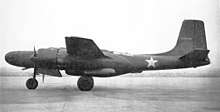
- XA-26A
- Serial no. 41-19505 served as a prototype night fighter with a crew of two - pilot plus radar-operator/gunner
- XA-26B
- Serial no. 41-19588 was a prototype "solid-nosed" attack variant with crew of three: pilot, gun loader/navigator (in front cockpit) plus gunner in rear, and carrying a forward firing 75 mm (2.75 in) cannon.[40]
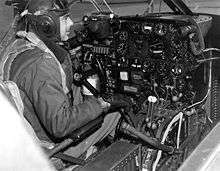
- A-26B
- Attack bomber with solid nose carrying six or eight 0.50 in (12.7 mm) machine guns. Production totals: 1,355 A-26Bs were built and delivered, 205 at Tulsa, Oklahoma (A-26B-5-DT to A-26B-25-DT) plus 1,150 at Long Beach, California (A-26B-1-DL to A-26B-66-DL). About 24 more airframes were built at Long Beach but not delivered to USAAF, some of those later sold to other civil and military customers. A-26B was redesignated B-26B with USAF in 1948.[41]
- TB-26B
- Unarmed variant converted from B-26B for training purposes.
- VB-26B
- Unarmed variant converted from B-26B for administrative purposes.
.jpg)
- A-26C
- Attack bomber. Production totals: 1,091 A-26Cs were built and delivered, five at Long Beach, California (A-26C-1-DL and A-26C-2-DL) plus 1,086 at Tulsa, Oklahoma (A-26C-16-DT to A-26B-55-DT). About 53 more airframes were built at Tulsa but not delivered to USAAF, some of those later sold to other civil and military customers. A-26C was redesignated B-26C with USAF in 1948.[42]
- RB-26C
- Unarmed photo reconnaissance variant converted from B-26C; it carried cameras and flash flares for night photography. Designated FA-26C prior to 1962.
- TB-26C
- Unarmed variant converted from B-26C for training purposes.
- XA-26D
- Serial no. 44-34776 prototype for the proposed A-26D attack bomber with uprated Chevrolet manufactured R-2800-83 engines, and late model A-26B armament of eight 0.50 in (12.7 mm) machine guns in solid nose and six 0.50 in (12.7 mm) guns in the wing;[43] series of 750 A-26Ds was cancelled after V-J Day.
- XA-26E
- Serial no. 44-25563 prototype for the A-26E attack bomber. As with the XA-26D but with an A-26C-type glass nose;[43] a contract for 2,150 A-26E-DTs was cancelled following V-J Day.
- XA-26F
- Serial no. 44-34586 prototype for a high-speed A-26F powered by two 2,100 hp (1,600 kW) R-2800-83 engines driving four-bladed propellers with a 1,600 lbf (7.1 kN) s.t. General Electric J31 turbojet installed in the rear fuselage. The prototype reached a top speed of 435 mph (700 km/h) but the series was cancelled as performance gains were not sufficient.
- A-26Z
- Unofficial designation for a proposed postwar production version of the A-26. It was to have a more powerful version of the Pratt & Whitney R-2800 radial engine and was to be fitted with such features as a raised pilot's cockpit canopy, an improved cockpit arrangement and wingtip drop tanks. If produced, the unglazed nose version would have been designated A-26G and the glazed nose version A-26H. However, in October 1945, the USAAF concluded that there were enough A-26 aircraft to meet postwar needs, consequently, the "A-26Z" version was not produced.
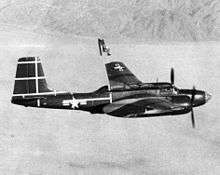
- JD-1
- U.S. Navy version with one A-26B (AAF Ser. No. 44-34217) and one A-26C (AAF Ser. No. 44-35467) redesignated during World War II, postwar, 150 surplus A-26s for use by land-based Navy utility squadrons (VU) as target tugs and later, drone directors (designated JD-1D) and general utility aircraft. In 1962, the JD-1 and JD-1D were redesignated UB-26J and DB-26J respectively.
- YB-26K
- On Mark Engineering prototype for refurbished attack bomber; modifications included rebuilt, strengthened wings, enlarged tail assembly, new R-2800-103W engines with reversible propellers/propeller spinners, dual controls, wingtip tanks, newer avionics and increased hardpoint/armament enhancements.
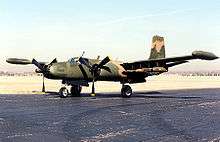
- B-26K
- On Mark Engineering conversions of 40 B-26Bs or TB-26Bs with two B-26Cs and a single JB-26C; changes included fitting of 2,500 hp (1,900 kW) R-2800-52W engines with no propeller spinners and the six wing guns deleted. During operations in Vietnam, in May 1966, the aircraft were reassigned the old attack designation of A-26A.[N 1] The A-26As were retired in 1969 when they had reached the safe limits of allotted flying time.[44]
- RB-26L
- Two RB-26Cs (44-34718 and 44-35782) modified for night photography missions.
- B-26N
- Unofficial designation applied to B-26s operated by the French Air Force (Armée de l'air) in Algeria as night fighters. These aircraft were modified B-26Cs fitted with AI Mk X radar taken from obsolete Meteor NF 11 night fighters, two underwing gun packs each with two 0.50 in (12.7 mm) M2 Browning machine guns and SNEB rocket pods.[45]
- WB-26
Weather reconnaissance version first produced and used in the Korean War, 2 used by NOAA from 1960-1975.[46]
Third-party civil variants
Since 1945, over 300 A-26s have been on the FAA U.S. Civil Aircraft Register. Perhaps up to a hundred of those were probably only registered for ferry flights from USAF bases such as Davis-Monthan AFB, AZ and Hill AFB, UT to civil airports and stored as candidates for sale on the civil or overseas military markets.[47]
The initial main civil uses were as "executive" personnel transports with minimal modifications such as removal of military features, bomb bay doors sealed shut, passenger entry stairs in bomb bay, and the conversion of the fuselage to accept six to eight passengers.[48] Improvements developed considerably until the early 1960s, when purpose-built executive types such as the turboprop Gulfstream I started to become available.[48]
During the mid-1950s, A-26s were tested and used as air tankers for suppression of forest and wildland fires, and may have briefly used borate-based retardants, hence the inaccurate and unofficial term "borate bombers." Borate was soon discontinued due to its undesirable ecologic effects, replaced with retardant mixtures of water, clays, fertilizers and red dyes. That use of A-26s on USDA contracts was discontinued in major regions by about 1973, when many of the A-26 air tankers then found willing purchasers in Canada.[11]
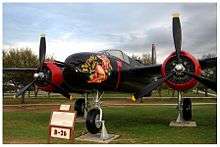
Much early development of conversions was carried out by Grand Central Aircraft, whose drawings and personnel were taken up by the On Mark Engineering Company of Van Nuys, California from about 1955. By the 1960s, On Mark had obtained an exclusive licence from Douglas Aircraft Company for manufacture and sale of parts for A-26s.[49] The on Mark Executive (1956), the on Mark Marketeer (1957), and the more radical pressurized On Mark Marksman (1961) were products of this effort.[48]
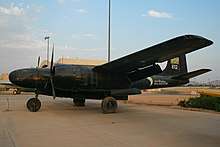
The next most significant conversion was the Rock Island Monarch 26, while less numerous and more basic conversions for executive operations were carried out by Wold Engineering, LB Smith Aircraft Corp., R. G. LeTourneau Inc, Rhodes-Berry Company [N 2]and Lockheed Aircraft Service Inc.[11][51] Garrett AiResearch used two A-26 variants as testbeds for turbine engines; see also XA-26F above.[52]
Operators (military and civilian)
Surviving aircraft
Specifications (A-26B Invader)
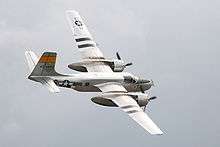
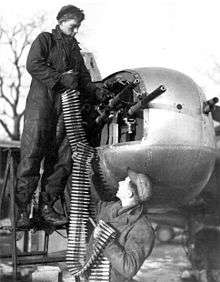
Data from McDonnell Douglas aircraft since 1920 : Volume I[53][54]
General characteristics
- Crew: 3
- Length: 50 ft (15 m)
- Wingspan: 70 ft (21 m)
- Height: 18 ft 6 in (5.64 m)
- Wing area: 540 sq ft (50 m2)
- Airfoil: NACA 65-215[55]
- Empty weight: 22,370 lb (10,147 kg)
- Gross weight: 27,600 lb (12,519 kg)
- Max takeoff weight: 35,000 lb (15,876 kg)
- Fuel capacity: 925 US gal (770 imp gal; 3,500 l) normal + optional 675 US gal (562 imp gal; 2,560 l) ferry tank in the bomb bay ; Oil capacity 60 US gal (50 imp gal; 230 l) in two nacelle tanks
- Powerplant: 2 × Pratt & Whitney R-2800-71 Double Wasp or -27s, or -79s 18-cylinder air-cooled two-row radial piston engines, 2,000 hp (1,500 kW) each for take-off
- Propellers: 3-bladed Hamilton Standard Hydromatic, 12 ft 7 in (3.84 m) diameter constant-speed fully-feathering propellers
Performance
- Maximum speed: 359 mph (578 km/h, 312 kn) at 16,700 ft (5,100 m) (normal rated power)
- Cruise speed: 266 mph (428 km/h, 231 kn) at 5,000 ft (1,500 m) (62.5% rated power)
- Range: 1,600 mi (2,600 km, 1,400 nmi) without ferry tank at 5,000 ft (1,500 m) at 206 mph (179 kn; 332 km/h)
- Combat range: 700 mi (1,100 km, 610 nmi)
- Ferry range: 3,000 mi (4,800 km, 2,600 nmi) with ferry tank at 5,000 ft (1,500 m) at 210 mph (180 kn; 340 km/h)
- Service ceiling: 28,500 ft (8,700 m)
- Service ceiling on one engine: 14,400 ft (4,400 m)
- Time to altitude: 10,000 ft (3,000 m) in 8 minutes 6 seconds
- Wing loading: 51.1 lb/sq ft (249 kg/m2)
- Power/mass: 0.145 hp/lb (0.238 kW/kg)
Armament
- Guns:
- 6 or 8 0.50 in (12.7 mm) M2 Browning machine guns in solid, "all purpose" nose: or 2 0.50 in (12.7 mm) M2 machine guns in glass "bombardier" nose
- Up to 8 0.50 in (12.7 mm) M2 machine guns paired in four optional under wing pods: or 3 0.50 in (12.7 mm) M2 machine guns in each outer wing panel
- 2 0.50 in (12.7 mm) M2 machine guns in remote-controlled dorsal turret
- 2 0.50 in (12.7 mm) M2 machine guns in remote-controlled ventral turret
- Rockets: Up to 10 5-inch (12.7 cm) HVAR rockets on "zero length" launch pylons, five under each outer wing panel
- Bombs: Up to 6,000 lb (2,700 kg) capacity - 4,000 lb (1,800 kg) in the bomb bay plus 2,000 lb (910 kg) carried externally on underwing hardpoints
Notable appearances in media
In July 2005, the archaeological television program Time Team of the UK's Channel 4, along with members of RAF Millom Museum, took part in a major project to excavate the crash sites of two A-26 Invader aircraft that had collided shortly after take-off over marshes close to the then USAAF BAD 2 airbase at Warton in Lancashire on 29 November 1944. The aircraft, A-26B-10-DT 43-22298 and A-26B-15-DT 43-22336, had been en route to Brétigny, Oise, in northern France to take up service with the 641st Bombardment Squadron of the 409th Bombardment Group.[56]
See also
- Water bomber
- SHORAN
Related development
Aircraft of comparable role, configuration and era
Related lists
References
Notes
- According to a "Wings" (Discovery Channel) documentary, the B-26 was redesignated the A-26, because Thailand would not allow bombers to fly from their airfields, but they would allow attack aircraft to do so.
- The R-B Silver Sixty (1960) carried 14 seats; first flight of the prototype N5510V occurred on 25 June 1960.[50]
Citations
- "Colombian Air Force." napoleon130.tripod.com. Retrieved: 19 December 2010.
- "Boeing: Historical Snapshot: A-26/B-26 Invader Light Bomber". www.boeing.com. Retrieved 15 March 2018.
- Knaack, Marcelle Size. Encyclopedia of US Air Force Aircraft and Missile Systems: Volume 1 Post-World War II Fighters 1945-1973. Washington, DC: Office of Air Force History, 1978. ISBN 0-912799-59-5.
- Wheeler 1992, p. 82.
- Francillon 1979
- Smith, A.M.O., "High-Lift Aerodynamics; the 37th Wright Brothers Lecture", AIAA paper 74-939, reprinted in the AIAA Journal of Aircraft, Vol. 12 No. 6, June 1975.
- Lednicer, David. The Incomplete Guide to Airfoil Usage. Archived 20 April 2010 at the Wayback Machine Champaign, Illinois: UIUC Applied Aerodynamics Group, 2010. Retrieved: 18 May 2011
- Mesko 1980, p. 5.
- Borland, Hal. "Plane of Many Faces." Popular Science, July 1945.
- Winchester 2004, p. 75.
- Thompson 2002
- Johnsen 1999
- Thompson 2002, p. 34.
- "June 1944." 43rd Bomb Group Association via kensmen.com, 1999. Retrieved: 2 August 2007.
- O'Leary 2002, p. 42.
- Mesko 1980, p. 17.
- Mesko 1980, p.12.
- Weiner, T. (2007). Legacy of ashes: The history of the CIA. Doubleday, New York, NY, pp 150-151.
- Horne 1984, p. 50.
- "452 Operations Group (AFRC)." Archived 7 May 2011 at the Wayback Machine Air Force Historical Research Agency, December 1997. Retrieved: 18 April 2010.
- Francillon 1978, p. 228.
- "A-26." Military.CZ. Retrieved: 19 December 2010.
- Dorr and Thompson 2003, p. 185.
- Troung, Albert Grandolini and Tom Cooper. Laos, 1948-1989; Part 1." acig.org, 13 November 2003. Retrieved: 6 November 2007.
- Smith 1966, p. 7.
- Smith 1966, p. 6.
- Mesko 1987, pp. 26–28.
- Thompson 2002, pp. 138–141.
- Playground Daily News, Fort Walton Beach, Florida, 12 February 1964, p. 1.
- Playground Daily News, Fort Walton Beach, Florida, 8 April 1964, p. 1.
- Volume I Operation Shed Light Study Report, 1966. pp. 1C-55, 59.
- Hagedorn and Hellström 1994
- Wyden, Peter. Bay of Pigs: The Untold Story. New York: Simon & Schuster, 1979. ISBN 0-671-24006-4.
- Overall, Mario E. Bay of Pigs: The Guatemalan Connection. London: Frank Cass Publishers, 2003. ISBN 0-7146-4883-3.
- Dorr and Bishop 1996, pp. 8–10.
- Cooper, Tom and Marc Koelich. "Far East Database, Clandestine US Operations: Indonesia 1958, Operation 'Haik'." acig.org, 1 September 2003. Retrieved: 19 December 2010.
- Time Magazine, 9 June 1958.
- O'Leary, Michael. "B-26." Air Classics, October 2002.
- Andrew Hudson, 2012, "Congo Unravelled: Military Operations from Independence to the Mercenary Revolt 1960–68 (Africa@War Book 6)", Chapt.6
- Francillon 1978, p. 217.
- Baugher, Joe. "A-26B Invader." USAAC/USAAF/USAF Bomber Aircraft, 17 September 2000. Retrieved: 19 December 2010.
- Baugher, Joe. "A-26C Invader." USAAC/USAAF/USAF Bomber Aircraft, 31 December 2000. Retrieved: 29 June 2008.
- Mesko 1997, p. 18.
- "USAF B-26K Factsheet." Archived 23 October 2013 at the Wayback Machine National Museum of the United States Air Force. Retrieved: 19 December 2010.
- Baugher, Joe. "Invader in Service with L'Armee de l'Air." USAAC/USAAF/USAF Bomber Aircraft, 26 August 2006. Retrieved: 7 November 2007.
- Dorst, Neal. "The National Hurricane Research Center - 50 Years of Research, Rough Rides, and Name Changes" (PDF). amol.noaa.gov. Retrieved 21 July 2020.
- Francillon 1978, p. 233.
- Grinsell 1974, p. 44.
- Francillon 1978, p. 234.
- "Rhodes Berry." aerofiles.com. Retrieved: 19 December 2010.
- Beck, Simon. "Douglas A-26 Invader." uswarplanes.net. Retrieved: 19 December 2010.
- "Power plants used by the A/B-26 in research and development". napoleon130.tripod.com. Retrieved 15 March 2018.
- Francillon, René J. (1988). McDonnell Douglas aircraft since 1920 : Volume I. London: Naval Institute Press. pp. 338–355. ISBN 0870214284.
- Bridgman, Leonard, ed. (1947). Jane's all the World's Aircraft 1947. London: Sampson Low, Marston & Co. pp. 224c–225c.
- Lednicer, David. "The Incomplete Guide to Airfoil Usage". m-selig.ae.illinois.edu. Retrieved 16 April 2019.
- "A-26B Invaders - Warton - 29th November 1944 - Bombers in the Marsh." Archived 24 July 2008 at the Wayback Machine Lancashire Investigative Team. Retrieved: 19 December 2010.
Bibliography
- Dorr, Robert F. and Chris Bishop.Vietnam Air War Debrief. London: Aerospace Publishing, 1996. ISBN 1-874023-78-6.
- Dorr, Robert F. and Warren Thompson. Korean Air War. St. Paul, Minnesota: MBI, 2003. ISBN 978-0-7603-1511-8.
- Francillon, René. "The Douglas Invader Story". Air Enthusiast, Number Seven, July–September 1978, pp. 215–234. Bromley, Kent, UK: Pilot Press Ltd., 1978.
- Francillon, René. McDonnell Douglas Aircraft Since 1920: Volume I. London: Putnam, 1979. ISBN 0-87021-428-4.
- Futrell, Robert F. The United States Air Force in Korea, 1950–53. Washington, D.C.: Air Force History Office, 1997, First edition 1961. ISBN 978-0-16-048879-5.
- Gallemi, Francis. A-26B/C Invader (Warbird Profile 1). Vaudreuil, Quebec, Canada: Aries Publications, 1994. ISBN 1-84176-080-3.
- Grinsell, Bob. "Invader." Wings Vol. 4, No. 3, June 1974.
- Hagedorn, Dan. Central American and Caribbean Air Forces. Staplefield, West Sussex, UK: Air Britain (Historians Ltd.), 1993. ISBN 0-85130-210-6.
- Hagedorn, Dan and Leif Hellström. Foreign Invaders, the Douglas invader in Foreign Military and US Clandestine Service. Earl Shilton, Leicester, UK: Midland Publishing, 1994. ISBN 1-85780-013-3.
- Horne, John E. "Douglas B-26s in Korea". Air Enthusiast, Number 24, April—July 1984. Bromley, Kent UK: Pilot Press. pp. 50–59.
- Johnsen, Frederick A. Douglas A-26 Invader. North Branch, Minnesota: Specialty Press, 1999. ISBN 1-58007-016-7.
- Mesko, Jim. A-26 Invader in Action (Aircraft Number 37). Carrollton, Texas: Squadron/Signal Publications, 1980. ISBN 0-89747-093-1.
- A-26 Invader in Action (Aircraft Number 134). Carrollton, Texas: Squadron/Signal Publications, 1993. ISBN 0-89747-296-9.
- VNAF, Republic of Vietnam Air Force 1945-1975. Carrollton, Texas: Squadron/Signal Publications, 1987. ISBN 0-89747-193-8.
- Mikesh, Robert C. "Flying the Invader: Pilot Notes for the Douglas A-26". Air Enthusiast, Number Seven. July–September 1978. Bromley, Kent, UK: Pilot Press Ltd., 1978, pp. 234–236.
- O'Leary, Michael. "Database:Douglas Invader". Aeroplane, May 2002, Vol. 30, No.5, pp. 37–58. London: IPC.
- Roeder, Jim. A-26 Invader Units of World War 2: Osprey Combat Aircraft 82. Botley, UK: Osprey Publishing, 2010. ISBN 978-1-84603-431-2
- Smith, Mark E. USAF Reconnaissance in South East Asia (1961–66). San Francisco: Headquarters, Pacific Air Force, Department of the Air Force, 1966.
- Thompson, Scott. Douglas A-26 and B-26 Invader. Ramsbury, Marlborough, Wiltshire, UK: Crowood Press Ltd., 2002. ISBN 1-86126-503-4.
- Thompson, Warren. B-26 Invader Units over Korea. Botley, UK: Osprey Publishing, 2000. ISBN 1-84176-080-3.
- Volume I Operation Shed Light Study Report. Washington, D.C.: Headquarters, DCS Research and Development, Headquarters, United States Air Force, 1966.
- Wheeler, Barry C. The Hamlyn Guide to Military Aircraft Markings. London: Chancellor Press, 1992. ISBN 1-85152-582-3.
- Winchester, Jim. "Douglas A-26 Invader." Aircraft of World War II. London: Grange Books, 2004. ISBN 1-84013-639-1.
- Bridgman, Leonard, ed. (1989). Jane's Fighting aircraft of World War II (1995 ed.). New York: Military Press. pp. 224c–225c. ISBN 0517679647.
External links
| Wikimedia Commons has media related to Douglas A-26 Invader. |
- Photo of prototype XA-26 41-19504
- Manual: (1945) AN 01-40AJ-2 Erection and Maintenance Instructions for Army Models A-26B and A-26C Airplanes
- A-26 Lady Liberty - Confederate Air Force
- Hill Aerospace Museum: Douglas A-26 "Invader" Information
- Hurlburt AFB: Fact Sheets: A-26 Counter-Invader
- Martin J Simpson's A-26 history website
- SH A-26 Sponsor Group - Commemorative Air Force
- Popular Science, July 1945, "Plane of Many Faces"
- Douglas A-26 Invader Registry
- Spherical panoramas of the interior of the 'Spirit of North Carolina'